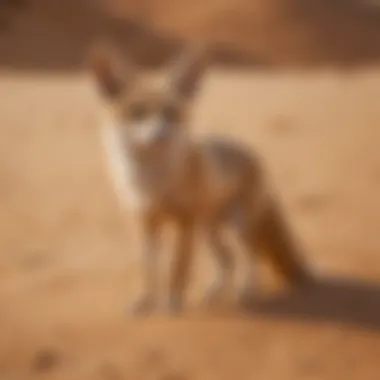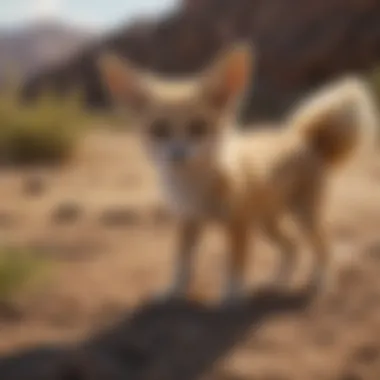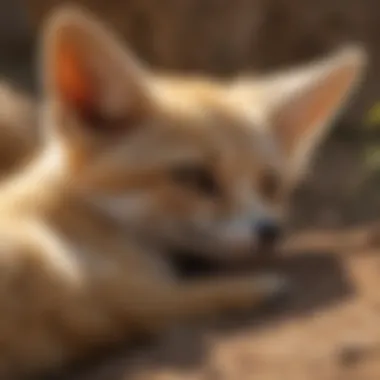Discover Fun Facts About the Fascinating Fennec Fox


Intro
The fennec fox is a tiny but remarkable animal known for its large ears and bushy tail. Native to the Sahara Desert, it thrives in harsh, dry conditions that many other animals would find challenging. This nocturnal creature has adapted physically and behaviorally to its environment. Knowing about the fennec fox not only addresses an appreciation for unique wildlife but also emphasizes the importance of conserving its habitat. This section helps in understanding the significance of this animal in nature.
Nature Topic Overview
Exploring the wold of the fennec fox unveils a set of striking traits and adaptations. The Sahara offers a backdrop where this fox's behavior, diet, and nresting characteristics come into play. Learning about these aspects will help children not only understand the fennec fox but also recognize the connectedness of all creatures that share the same ecosystem.
Fun Facts and Trivia
Here are some engaging facts about the fennec fox:
- Largest ears: The fennec fox has ears that can grow up to 6 inches long. They help in hearing above ground and radiate body warmth.
- Tiny size: Weighing about 2 to 3.5 pounds, it is the smallest canid in the world. Their size helps them adapt to heat.
- Active at night: This fox prefers the cooler temperatures of the night. It is an expert at hunting and foraging under the veil of darkness.
- Diverse diet: Fennec foxes eat insects, plant matter, rodents, and sometimes fruit.
Interactive visuals are great for learning. Pictures and short videos can illustrate these facts to help young readers grasp what makes these creatures special.
Wildlife Explorations
Understanding the fennec fox opens doors to learn about other species in the Sahara Desert. For example, the desert hedgehog and various types of rodents coexist in its environment. Here are key points to consider:
- Desert hedgehogs also adapt well to heat, showcasing unique adaptations.
- Animals like hares also thrive in the desert but have different food sources.
- These species can teach us about food chains and interactions within their habitat.
Interactive Features
Quizzes about which animals share habitats with the fennec fox can enhance this learning experience. Simple questions like “which animal can be found in the desert?” can create an interactive learning moment.
Environmental Awareness
With understanding comes responsibility. Young learners should realize why conservation is crucial. The fennec fox is a part of a delicate ecosystem where the balance can easily be disrupted.
Tips for young learners:
- Reduce waste: Teach incentive with proper waste disposal.
- Support conservation organizations through acknowledging groups focused on the Sahara.
Quote for Thought
Conseravtion isn’t a one-man job; it takes everyone to build strong onsiscious choices about nature.
DIY Nature Activities
Children can delve deeper by engaging in practical projects. Here are a few activities:
- Create a fennec fox puppet: Using simple craft materials, guide them in making their own puppets.
- Nature journals: Encourage them to write or draw anything related to what they learn about the fennec fox.
- Outdoor scavenger hunt: Gather items that represent desert wildlife, like dried leaves.
These activities enhance their understanding in a fun, memorable way while stimulating their creativity and critical thinking.
Integrating facts and activities will make learning richer and provide practical insights into nature. By engaging with this content, children can develop a deeper respect for wildlife and support their continued preservation.
Preamble to the Fennec Fox
The fennec fox is a remarkable creature that showcases a range of unique traits valuable to understanding desert wildlife. By introducting the fennec fox, readers open the door to discovering its adaptations, behaviors, and role within the Sahara Desert ecosystem. Engaging with the specifics of this animal grabs attention and can inspire curiosity in young learners about not only this species, but the broader environment.


What is a Fennec Fox?
The fennec fox is a small fox with distinctive features. It is immediately recognized by its large ears, fluffy tail, and small size. Typically, fennec foxes reach about 24 to 41 centimeters in length and weigh roughly 1.5 to 3.5 kilograms. These small foxes are known for their nocturnal lifestyle, primarily active during the night when they search for food in the wild.
Fennec foxes live in family units led by a dominant pair. They are social animals, enjoying interaction with each other, which forms a part of their survival strategy. The size of their families can vary based on the habitat and availability of food.
Habitat and Distribution
Fennec foxes are native to the Sahara Desert and surrounding regions. They thrive in arid conditions with sparse vegetation. Their habitat ranges across several countries in North Africa. This includes areas in Morocco, Algeria, Tunisia, and Libya.
The desert environment poses unique challenges and the fennec fox has adapted superbly to these conditions. For instance, they often create elaborate burrows to escape the daytime heat. They may go deep into the sand, which provides a cooler space to rest.
Physical Characteristics
Physical characteristics of the fennec fox are vital to understanding the adaptations that make this animal unique. Knowing these traits helps us appreciate how the fennec fox has evolved to thrive in its harsh habitat, the Sahara Desert. From its size to design and survival skill, each aspect is tailored for endurance under challenging conditions.
Size and Weight
The fennec fox is one of the smallest foxes in the world. It typically stands about 10 inches tall at the shoulder and can weigh between 1.5 to 3.5 pounds. Its small size allows it to navigate complex burrow systems easily and find various places to sleep during the day to avoid the extreme heat.
With such a lightweight form, they can quickly move and hunt for their food during nighttime. Their size also contributes to their ability to escape potential predators by hiding in tight spots.
Distinctive Features
Fennec foxes have several distinctive features. The most notable is their large ears, which can be about 6 inches long. These ears are not only cute, but they also serve essential purposes. In addition to hearing sounds better, their size is useful for thermoregulation.
Their coat is another distinctive feature, it is pale beige with lighter-colored underbelly. This coloration not only helps them stay cool by reflecting sunlight but also allows them to blend in with the sandy environment, providing camouflage.
Adaptations for Survival
Large Ears for Thermoregulation
The large ears of the fennec fox play a crucial role in thermoregulation. They act like natural radiators, helping to dissipate heat during the hottest parts of the day. The significant surface area allows for more blood to flow through, releasing unwanted body heat effectively. This feature is not commonly found in many small mammals, making it a beneficial adaptation for the desert climate. The large ears are also adapted to hear very quiet sounds, which is essential for locating prey at night.
Fur Coloration and Texture
The fur color of the fennec fox is a clever adaptation to its environment. Its light beige color reflects the harsh sunlight, preventing overheating. The texture of the fur is thick, which offers insulation against the cool desert nights. Their fur also keeps their skin protected from the sand. As an adaptation, this helps maintain their body temperatures, making it effective for both hot days and cooler nights. The unique coloration and softness of that fur is an essential aspect of their survival.
Behavior and Social Structure
Understanding the behavior and social structure of the fennec fox provides valuable insights into how these animals thrive in their natural habitat. Their nocturnal lifestyle, along with complex social interactions, contribute significantly to their survival and reproductive success. By studying these aspects, readers can learn about the challenges and adaptations that define the fennec fox's life in the Sahara desert.
Nocturnal Lifestyle
Fennec foxes are primarily nocturnal, which means they are active during the night. This behavior helps them avoid the intense heat of the day. By moving around at night, they reduce the risk of overheating. They have developed special adaptations, like large ears, which not only help them cool down but also make them excellent at hearing into the night.
Within their nocturnal habit, fennec foxes are very playful and full of energy. They use nighttime to engage in social behaviors, explore, and hunt. Their eyes, which are adapted for low light, allow them to see well in the darkness, making it easier for them to navigate their environment. This nighttime activity is criticial for finding food and avoiding predators.
Social Interactions
Despite being solitary hunters, fennec foxes have intricate social lives. Their social interactions revolve around family units and hierarchy, which affects how they interact with other creatures and their surroundings.
Territorial Behavior


Territorial behavior in fennec foxes is marked by distinct boundaries that each family group maintains. This is a crucial aspect because it minimizes conflict with neighboring groups. It ensures that each unit has access to adequate resources like food and shelter.
A key characteristic of this behavior is scent-marking. Fennec foxes use scents from glands to communicate territory boundaries to others. This behavior reduces aggressive encounters and damages that can happen from fighting over resources. However, maintaining a territory also has its risks. Marking a territory calls attention to itself, which means they could attract predators when marking or defending their area.
Family Units
Fennec foxes arrange in tight family units consisting of parents and their kits. These structures are vital for the upbringing of the young. Kits benefit from the care and protection their parents provide as they learn essential survival skills. A unique feature of family units is cooperation in hunting and guardianship. For instance, while one parent hunts, another attends to their young, ensuring safety and nourishment.
Yet, family units do come with certain challenges. The presence of multiple family members can lead to competition for food, especially in tough living conditions where resources are fewer. Still, this competition often encourages hunting efficiency, often making fennec foxes agile hunters.
Understanding their behavior and social structure allows young learners to appreciate the intricate relationships fennec foxes share with each other and their environment.
Diet and Hunting Techniques
Understanding the diet and hunting techniques of the fennec fox is vital to appreciating its role in the ecosystem. This small desert dweller has developed unique eating habits and skills that allow it to thrive in the challenging Sahara environment. Its diet and foraging methods provide not only individual survival but also contribute to the health of its native habitat.
Dietary Preferences
Fennec foxes exhibit omnivorous dietary preferences, primarily consuming insects, small mammals, and plants. Here’s a closer look at what they typically eat:
- Insects: A significant portion of their diet comes from insects such as beetles, crickets, and grasshoppers. These are high in protein and easy to catch because of the fox's agility.
- Small Mammals: Occasionally, they will hunt small mammals, including rodents and birds. Given their size, fennecs use stealth to approach and capture these quick creatures.
- Vegetation: They also eat fruits, seeds, and roots. This can be particularly important during seasons when animal prey is scarce.
Each component of their diet is essential for providing them with the necessary nutrients to sustain their energy, especially as they are nocturnal and active during cooler nighttime temperatures.
Hunting and Foraging Skills
The fennec fox employs several impressive techniques for hunting and foraging:
- Burrowing Skills: Fennec foxes are adept at digging. They use this skill not only to find food hidden in the sand but also to create burrows for shelter.
- Silent Movement: Their ability to move quietly allows them to sneak up on prey, drastically improving their success rate when hunting insects or small mammals.
- Working Together: While they can hunt individually, fennec foxes sometimes engage in cooperative hunting. This increases their chances of catching faster prey.
- Use of Senses: Having strong hearing and sense of smell, fennec foxes can locate prey hidden beneath the sand. Their large ears can detect sounds made by insects and small creatures moving underground.
These skills demonstrate the fennec fox’s adaptability and resourcefulness, enabling it to thrive in an environment where resources can be limited. This knowledge helps to highlight the fennec’s role as both predator and prey in the desert ecosystem.
Adaptability in diet and hunting techniques allow the fennec fox to survive and contribute to biodiversity in the Sahara Desert.
Overall, the dietary preferences and hunting strategies of the fennec fox inform us about its survival in diverse conditions. Understanding these aspects is crucial for appreciating how this species fits perfectly into its own environments.
Role in the Ecosystem
The fennec fox plays an interesting and important role in the ecosystem of the Sahara Desert. Understanding its position helps us to appreciate how species interact within their environments. As both predator and prey, it contributes to maintaining the balance in its habitat.
Predator and Prey Dynamics
Fennec foxes are primarily nocturnal hunters. Their diet mainly consists of small rodents, insects, and occasionally fruits. This gives them a strategic position in the food web. They help control the populations of these small animals, which could otherwise grow too large. By keeping these populations in check, fennec foxes prevent overgrazing of vegetation and help maintain the ecosystem's health.
Additionally, the fennec fox itself is prey to larger predators, including owls, eagles, and larger desert mammals. This predator-prey relationship showcases its role as a vital component in the cycle of life within the desert ecosystem. Without fennec foxes, there could be an imbalance that affects various species. This shows how interconnected all creatures are in their environment.
Contributions to Biodiversity
The fennec fox helps enhance biodiversity. As a species, it contributes to the variety of life found in the Sahara. Their unique adaptations, such as their large ears for heat dissipation and playful nature, attract the attention of people and within its natural habitat. This creates interest in conserving fennec foxes and their environments.
Fennec foxes also assist in seed dispersal when they consume fruits. By doing this, they help maintain plant diversity in their ecosystems.
In summary, by filling these ecological roles, fennec foxes help to sustain a rich and varied desert ecosystem, demonstrating the importance of all species, regardless of their size, in preserving the balance of their habitat.


Conservation Status
Conservation status is critical to understanding the plight of the fennec fox. As a unique species in the vast Sahara Desert, it plays an important role in its ecosystem. Knowing about conservation status helps describe its vulnerabilities and protective measures needed. This information can foster a sense of responsibility in young readers to appreciate and help wildlife.
Threats to Fennec Fox Populations
Fennec fox populations face several threats. First, habitat loss remains a significant issue. Desert areas are often disturbed for agriculture and settlements, which leads to diminishing habitats for fennec foxes. Urban expansion also eats into their territory.
Additionally, poaching and illegal trapping contribute to a decline in their numbers. These animals are often taken as exotic pets, which disrupts their natural behaviors and can be harmful both to the animals and the ecosystems they inhabit.
Next, competition with domestic animals adds to their struggles. As people move into desert areas, home pets like cats and dogs can outcompete or hunt young fennec foxes, leading to population decrease. Furthermore, climate change alters the delicate balance of their environment, affecting food availability and water resources.
Awareness about these threats is essential. When people understand the risks, they are more likely to engage in efforts aimed at preserving such a fascinating species.
Conservation Efforts
Several conservation efforts focus on protecting the fennec fox. Wildlife reserves are especially important in creating safe havens for these animals. Such reserves ensure that their habitats remain intact and are monitored for damage.
Education is also key. Community programs inform individuals about the ecological and cultural importance of fennec foxes. The involvement of local communities can lead to sustainable practices that reduce habitat intrusion and protect these animals.
Another important approach is stricter law enforcement against poaching. Establishing laws that protect the fennec fox helps to control illegal activity and safeguard populations.
Lastly, collaborative actions with organizations such as the International Union for Conservation of Nature (IUCN) help measures in place for tracking and sustaining the species. Everyone's role can lead to significant positive outcomes for the fennec fox and their habitat because healthy ecosystems are vital for both nature and humanity.
Interesting Facts
Understanding the interesting facts about the fennec fox reveals much about its unique adaptations and importance within the ecosystem. These facts not only enhance our appreciation for this species, but also shed light on the ecological balance it helps maintain. Studying these nuances provides a richer perspective relevant for both young learners and their mentors.
Unique Vocalizations
The fennec fox is renowned for its unique vocalizations. Unlike many animals that utilize similar sounds, the fennec produces a variety of calls. These include barks, growls, and even high-pitched whines. Each sound serves a specific purpose:
- Communication: The vocal range helps them communicate with pack members, especially at night when visibility is low.
- Territorial Matters: Certain calls signal territory boundaries to other foxes, efficiently managing their living space.
- Alert Signals: Different sounds indicate the emotional state or hazards from predators, adding to their survival strategies.
Because they are nocturnal, these vocalizations play a vital role in how fennec foxes develop social relationships in their tightly knit family groups.
Cultural Significance
The fennec fox holds a notable place in various cultures, particularly in regions near the Sahara Desert. This small animal has become a symbol of resilience and adapting to extreme environments. Some ways in which fennec foxes are represented in culture include:
- Mythological Stories: Often featuring in local legends or folklore where it is depicted as a clever and stealthy creature.
- Wildlife Conservation Efforts: As an emblem for the importance of preserving desert ecosystems, the fennec raises awareness about habitat destruction and climate change.
- Popular Media: The fennec's distinctive features have made it a common subject in animation and art, engaging audiences globally.
These cultural narratives emphasize the role bilingual storytelling can play in educating children about both environmental issues and celebrating the rich diversity of wildlife.
Understanding such facts encourages respect and curiosity about the natural world, motivating the next generation to take part in conservation initiatives.
End
Understanding the fennec fox is essential for appreciating the unique characteristics they possess. The fennec fox thrives in the harsh conditions of the Sahara Desert, showcasing remarkable adaptations like their large ears and nocturnal behaviors. In this article, we explored their physical traits, habitat, hunting techniques, and role in ecosystem dynamics.
Recap of Key Points
- Physical Characteristics: The fennec fox weighs between two to four pounds and has notable features such as large, expressive ears.
- Behavior: Being nocturnal allows these foxes to evade heat and hunt effectively at night.
- Diet: Their diet mostly consists of insects, small rodents, and fruits, indicating their adaptability.
- Conservation: Understanding the various threats faced by fennec foxes highlights the need for conservation efforts to protect this extraordinary species.
Encouraging Further Exploration
Young learners, parents, and educators should take an interest in the fennec fox. Watching documentaries or visiting wildlife websites, like Wikipedia or Britannica, can provide more insights into their lifestyle. Discussing these facts with peers encourages curiosity about wildlife while emphasizing the importance of conservation.
The journey into the world of the fennec fox not only promotes awareness of animal behavior but also instills a sense of responsibility towards wildlife conservation efforts. Continue exploring and questioning the behavior and environment of your favorite animals, including the fennec fox!







